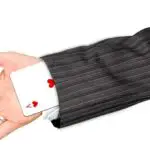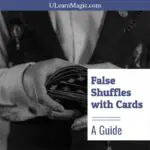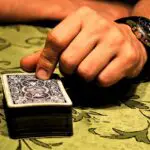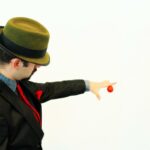Mentalism has become the newest type of magic to gain popularity in recent years. Not only that, but the amount of professional mentalists and teaching material has also grown tremendously.

In this post, we will explore mentalism in a complete guide to mentalism.
What is Mentalism?
Mentalism is a type of magic that is usually performed on stage (but doesn’t have to be) in which the performer will give the illusion that they are reading minds or performing incredible mental feats.
Generally, mind reading or telepathy is the most common effect used by mentalists. But another common effect is making a prediction about the future that comes true. Some mentalists will also appear to bend spoons with their mind or move objects using telepathy or mind control.
Also, sometimes you will see an effect in which the performer will demonstrate an incredible mental feat, such as advanced math calculations in their head or incredible feats of memorization.
(You can learn more at What is Mentalism? as well as a history of mentalism and more. If you are looking for tips to learn mentalism, visit How to Learn Mentalism)
Is Mentalism Real?
In cases of mentalism magic, it is not real but is an act, usually involving some type of trick or secret which allows the effect to be accomplished. But in many cases, it can look very real, especially for advanced performers. Banachek as a teenager had fooled University researchers into thinking he had psychic powers. See Project Alpha. Also, Uri Gellar had convinced people he could bend spoons with his mind.
(You can get access to a wide range of mentalism effects and mentalist tricks revealed here).
Usually, the performer is acting and pretending to either be reading minds or performing some other mentalist feat. In this sense, it can even be considered a type of performing art, just as magic can be.
Examples of Mentalism
Here are some common examples of mentalism effects.
1) Mind Reading
Mind reading is probably the most common effect of mentalism. This usually includes a spectator thinking of something such as a chosen card from a deck of cards or writing something down on a piece of paper that they are thinking of.
2) Predicting the Future
Knowing or predicting a future event is another common mentalism effect. This usually includes some kind of written prediction about a choice that a randomly chosen audience member would make.
3) Bending a Spoon or Metal Object

Some performers will do a spoon bend in their mentalism performance. This is the act of causing a spoon to bend by using the power of their mind. Although a spoon is usually the most commonly used object, some performers will use other metal objects such as nails, coins, or even a paper clip for close-up effects.
4) Advanced Mind Calculations
Sometimes a mentalist will perform what looks like a very advanced and impossible calculation using just the mind. This could be anything from computing a hard math problem to knowing what day of the week any named date falls on.
5) Blindfolding
Another popular effect with some mentalists is the use of a blindfold in their act. The performer is blindfolded, in which a blindfold will completely cover their face or eyes so they can’t see, and then they are able to still discern what is happening around them, or perform some type of effect that seems impossible while blindfolded.
6) Memorization
Some mentalists will perform advanced feats of memorization in their act. This could include memorizing a magazine or a long list of numbers or items created by the audience.
How Are Mentalism Tricks Done?
In the case of mind-reading, there is usually a trick or secret that allows the performer to gain knowledge or information about what the spectator is thinking. Or, there may be a force used to control what the spectator selects ahead of time.
(In fact, you can even purchase Mentalism courses, tricks, devices, and learning material from professional mentalists here from Vanishing Inc or you can get their mentalism instant downloads here. You can also get access to the Master Mentalism course here which provides secrets to lots of mentalist effects plus other magic tricks.)
In the case of predictions, sometimes there is a switch done in order to change the prediction. Or, there are multiple different predictions in order to satisfy whichever outcome happens.
When bending spoons or other objects, there is usually a secret grip or move which allows the object to be bent or moved without being seen. For telepathy and the movement of objects, there might be a wire or some other device. (In some cases, devices are used for mind-reading as well).
For cases of mental feats such as advanced math or memorization, there is usually some type of trick which allows the performer to do something which seems very much impossible to the average person. (Such as memorizing a very long list)
Mentalism Course
13 Steps to Mentalism
There is a Mentalism course that has been possibly the most popular mentalism course in modern times. This is called the 13 Steps to Mentalism and is taught by the famous performing mentalist, Richard Osterlind.
(You can grab the 13 Steps to Mentalism 6 DVD Course here at VanishingInc on sale and with free U.S. shipping)
The 13 Steps to Mentalism is based on the most popular Mentalism book of all time, which was the 13 Steps to Mentalism book by Tony Corinda. You can grab your hard copy of 13 Steps to Mentalism by Tony Corinda here at VanishingInc for under $30.
This book is considered a must-have for mentalists or magicians and covers things like the Swami Gimmick, mental tricks with cards, billets, slates, clipboards, blindfolds, Q&A acts, and stunts.
Richard Osterlind’s DVD course is a step-by-step guide to Tony Corinda’s 13 Steps to Mentalism book, in which he also performs live in front of an audience, so you can see the effects being actually performed.
Richard Osterlind also has tons of other learning DVDs, books, and downloads on mentalism. Check out all of Richard Osterlind’s mentalism products here.
Master Mentalism

The Master Mentalism course provides a large number of secrets of classic mentalism effects, as well as some other PDFs of magic tricks. You can get the Master Mentalism course here.
How to Control Minds Kit
Peter Turner, one of the biggest names in mentalism, has released the How to Control Minds Kit. The effects chosen are easy, yet powerful so that even beginners can get started with the kit. It’s said to be a blend of mentalism, psychology, magic and pseudo-hypnotic suggestion.
Grab the How to Control Minds Kit here.
Mentalism Tricks
What are some common mentalism tricks that can be done? We’ll have a look, including some free tricks as well.
1) Divine a Card
If you know a memorized deck stack such as Mnemonica stack, or you have a deck arranged in a predictable order such as Si Stebbins, you can know a card that a spectator chooses.
(Or watch Read Minds Easy With a Deck of Cards – Like Si Stebbins on YouTube here)
This is accomplished by being able to look at the next card in the sequence of cards after your spectator chooses a card. By knowing what this card is, you can go back one card in the stack and figure out the card the spectator chose.
For example, for the sake of simplicity, we will use a deck that is in new deck order. If the spectator cuts the deck and takes the top card and hides it in their pocket, you can know that card by looking at the card on the bottom of the deck. How? This card is known as a key card and will be the card that is the next card in the stack from the one the spectator chose.
So, if you look at the bottom of the deck and see the 7 of Hearts, then you know that the spectator is holding the card that came before the 7 of Hearts, which would be the 6 of Hearts.
2) Revealing a Thought of Card
You can know what card a spectator is thinking of or what they have written on a card by getting a peek at the card using some sleight of hand techniques. This can be done with playing cards, or by having them write something on a blank card.
Here’s another trick using a peek with a deck of cards or a pack of blank cards and a different sleight.
3) Revealing Writing on Torn Up Paper
The center tear is a classic move in mentalism, in which an audience member writes something on a billet or business card. The performer then takes the card and rips it up, revealing the information.
T-Rex is a famous center tear by Ran Pink. (Get T-Rex here) As of writing this, T-Rex looks like it might be discontinued. But, Ran Pink’s original famous center tear called Think Pink is still available (and cheaper). You can get Think Pink by Ran Pink here.
Also, Richard Osterlind does a lot of work on the center tear, so a lot of his work will feature the center tear. The 13 Steps to Mentalism even features a center tear section as well.
You can find other center tear tutorials here.
4) Triple Prediction
The one ahead principle is a classic principle in magic. Essentially, it involves the magician being one step ahead of the spectator and writing whatever they say, rather than making a prediction of what they will say (which is what the magician says is happening).
This is all made possible by a force of some kind for the last prediction. You could also make the last choice as something that is commonly chosen rather than having it be a force. This means sometimes you will get it right and sometimes not, but even when you don’t get it right, you will still get 2 out of 3 right, which most find impressive.
5) Bend a Spoon
There are many different ways to bend a spoon that exceed the capacity of this guide. One of the most common ways uses sleight of hand to do a secret hidden move that makes it look like the spoon is bending, even though it might not be actually bending, or it might be already secretly bent.
There are also some gimmicks on the market, which are spoons that will bend themselves.
(You can find spoon bending techniques and gimmicks here)
Menny Lendenfeld is a master mentalist, and he offers numerous spoon bending techniques, key bending, plus other mentalist tricks in his Menny Lendenfeld Live Lecture. (Less than $8)
6) Predict a Card or Object
By doing a card force, you can predict ahead of time a chosen card. Or, you can reveal the card that the spectator is thinking of since you already know it ahead of time.
(Or watch Baffling Self-Working Prediction Card Trick on YouTube here)
You can also predict outcomes of choices by using everyday objects, and something called Magician’s Choice, which is a fancy way of saying that you force them to choose a certain object.
There is also something you can buy called a Change Bag or Force Bag, which allows you to force objects, cards, or a lot of different things on a spectator. Check out Force Bags and Change Bags here.
7) Reveal Writing On Folded Up Paper
Very similar to the center tear, there are numerous billet peaks in which the piece of paper is not torn up, but the information is still peeked using sleight of hand. Acidus Novus is a classic example of this.
(ESPidus Novus combines Acidus Novus with other Mentalism techniques for an awesome little routine. Download ESPidus Novus instantly here.)
8) The Invisible Deck
The Invisible Deck is one of the greatest props in the history of magic. A spectator names a card and you reveal that you had turned that card over in the deck ahead of time.
There are many ways you can present the Invisible Deck trick, but this is one that gives it more of a mentalist or prediction effect, rather than just a magic effect.
(Watch Spectator’s Freely Chosen Card Matches! on YouTube here)
Learn more about the Invisible Deck at our The Invisible Deck Guide.
9) Bend a Coin
There are a couple of different devices to bend coins and make it look like an act of mentalism.
The Ox Bender by Menny Lindenfeld is one. As well as the Rasmus Real Coin Bend.
Check out all coin bending devices and tutorials here.
10) Brainwave
Brainwave is a classic card trick in magic, but it also is a mentalism effect. The magician has a packet of 8 cards that they show to the spectator and the spectator chooses one of the cards.
The magician then shows that all the other cards had a different colored back except for the one the spectator named.
11) Which Hand is the Coin In?
The “which hand is the coin in?” trick is a premise in mentalism, in which the mentalist is able to accurately identify which hand a spectator keeps hiding a coin in.
There are methods that involve the spectator following instructions in order to determine where it is, as well as devices that can detect where it is.
Tequilla Hustler is a book with a method for doing a ‘which hand’ trick without a gimmick.
X-Ray by Rasmus is a set of gimmicks for doing a ‘which hand’ routine.
See all ‘Which Hand’ tricks and devices here.
12) The Book Test
The Book Test is a classic trick in mentalism. The spectator will look at a sentence in a book and think of that sentence, a word from that sentence, or a picture from the book.
The magician will then discern what the spectator is thinking.
There are some easier versions that involve no gimmicks, just a clever method. Then there are Book Tests that use special gimmicked books for even stronger performances.
The Ultimate Book Test by Luca Volpe found here is one. Another is the Zandman Book Test found here.
Best Mentalists to Learn From
Here’s a list of some of the best mentalists and top performers to learn mentalism from.
1) Richard Osterlind
A classic mentalist performer. Richard has tons of material that teaches mentalism and he’s an excellent performer. He produced the popular 13 Steps to Mentalism DVDs. Or browse all of Richard Osterlind’s works.
2) Steve Banachek
Banachek had convinced University researchers as a teenager that he had actual psychic powers. Banachek has lots of mentalism material. You can find Banachek’s instructional material here.
3) Derren Brown
Derren is one of the most famous mentalists of all time. He does not teach very much, but he does have a lecture and a few materials. View the Derren Brown Lecture here.
4) Bob Cassidy
Cassidy is an older performer like Osterlind with tons of experience and teaching materials and billet work. Browse Bob Cassidy’s teaching material here.
5) Peter Turner
Peter is one of the younger mentalists, who has grown in extreme popularity. The interesting thing is Peter studied a lot of Bob Anneman and incorporates a lot of this old work in new ways.
Check out Peter Turner’s How to Control Mind’s Kit for easy yet powerful mentalism effects.
Or view Peter Turner’s Lectures and teaching materials.
6) Mark Elsdon
Mark does regular magic as well, but he also has a strong emphasis on mentalism. You can find all of Mark Elsdon’s teachings here.
The magician started magic as a kid and has learned from some of the greats. He loves to share his knowledge with others and help out with the subtleties he’s learned along the way.
Follow on YouTube at the link below to get free tricks and advice!







